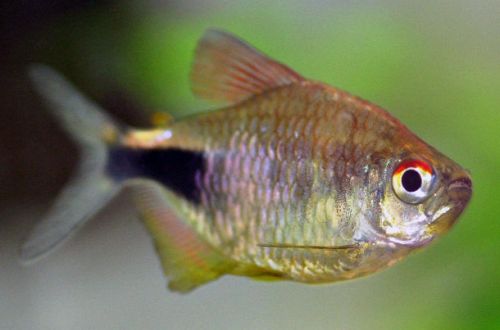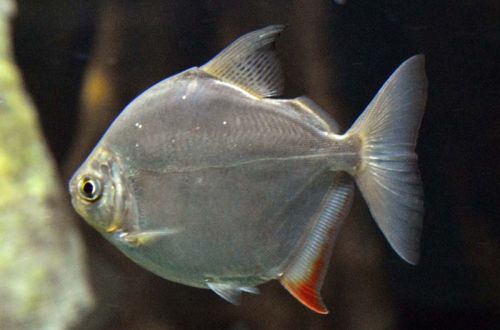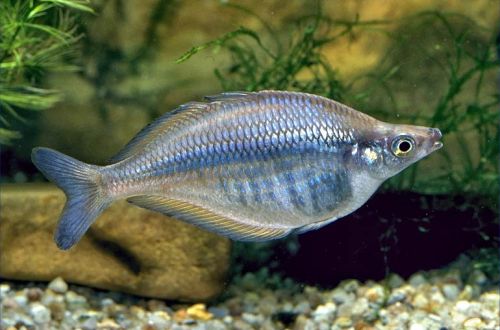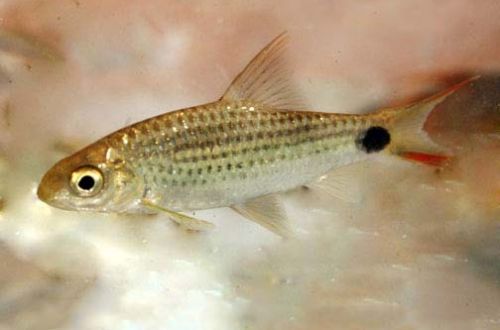
Pulcher
Pulcher, scientific name Hemigrammus pulcher, belongs to the Characidae family. Despite its extremely limited natural distribution, the fish has become popular with aquarists around the world due to its unpretentiousness, easy breeding and compatibility with many other fish.

Contents
Habitat
Endemic to a small area in the Upper Amazon in what is now Peru (South America). It lives in slow-moving tributaries of the main river channel, flowing through tropical rainforest. At present, it is almost impossible to find wild-caught fish for sale, the vast majority of specimens come from commercial aquariums.
Brief information:
- The volume of the aquarium – from 70 liters.
- Temperature – 23-27°C
- Value pH — 5.5–7.0
- Water hardness – soft (1-12 dGH)
- Substrate type – any sandy
- Lighting – subdued
- Brackish water – no
- Water movement is weak
- The size of the fish is about 4.5 cm.
- Food – any food
- Temperament – peaceful
- Keeping in a flock of at least 6-10 individuals
Description
Outwardly, the fish resembles its close relative Tetra-lantern, has the same dimensions (up to 4.5 cm) and a characteristic feature – a red pigment in the upper region of the eye. The differences lie in the pattern and color of the body, the Pulcher lacks two dark dots, they are replaced by a large black stroke at the base of the tail, and the main color, in addition to silver, has a yellow / lemon tint.
Food
Accepts almost all types of dry and freeze-dried industrial food for aquarium fish. However, it will not be superfluous if the diet is periodically replenished with live or freshly frozen foods, such as bloodworms, daphnia, brine shrimp, etc.
Maintenance and care, arrangement of the aquarium
A very unpretentious fish, it feels great even in an empty aquarium. However, you should not keep it in such spartan conditions. Your swimming pets certainly deserve more comfort. A universal option is a tank with a volume of 70 liters or more, the design of which uses a sandy river substrate, a pair of snags (natural or decorative) and several rooting and floating plants. Aquarium equipment is set up in such a way that the lighting fixtures give a subdued light, and the working filters do not cause a strong current.
Water conditions are characterized by a slightly acidic pH value with low hardness, the temperature range varies between 23–27°C. To color the water in the tea color characteristic of the Pulcher’s natural habitat, you can use a cloth bag with peat specially treated for aquariums (purchased exclusively in pet stores) or dry fallen leaves. The leaves are pre-soaked for about a week,
for example, in a plate/cup, and only then placed in the aquarium, otherwise they will float on the surface.
Maintenance is reduced to a weekly replacement of part of the water (10–15% of the volume) with fresh and regular cleaning of the soil from organic waste, and glass from plaque.
Behavior and Compatibility
Peaceful calm look, content in a flock of at least 6 individuals. It goes well with most other peaceful fish of similar size and temperament. The danger is represented by larger fish, which may perceive Pulcher as an additional source of food.
Breeding / breeding
At home, it will not be difficult to get offspring, the fish will breed even in a common aquarium, but in this case the survival rate of the fry will be extremely small. They will become a victim not only of their neighbors in the aquarium, but also of their own parents.
If you plan to start breeding, you should purchase a separate tank with a volume of about 20–30 liters, you can do it without registration, the main thing is to prepare several dense small-leaved plants or mosses that will protect the eggs from being eaten. The same purpose is served by a mesh in a small cell located at the bottom, or a layer of glass beads. Of the equipment, a simple sponge airlift filter and a heater are sufficient. The lighting system can be neglected, the light coming from the room will be more than enough.
Spawning is stimulated by a gradual change in water conditions until the pH values are set at around 5.5–6.5 at low carbonate hardness (dH 1–5). The temperature rises to 27°C. The daily diet includes a large amount of live food.
After a while, the females become noticeably rounder, this will mean the approach of the mating season. Females and the strongest males are transplanted into a separate tank, which is filled with water from a common aquarium. At the end of spawning, the fish are returned back. The fry appear within 24-36 hours, and after another 3-4 days they begin to swim freely, from this moment it is necessary to start feeding them with specialized food for juvenile aquarium fish.
Fish diseases
A balanced aquarium system with the right conditions is the best guarantee against any disease in the Flashlight Tetra. Therefore, if the behavior of the fish has changed, the color has changed, non-characteristic spots have appeared, and so on, first check the water parameters, and only then proceed to treatment.





